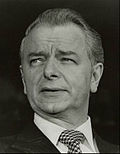| |||||||||||||||||
| |||||||||||||||||
 County results Byrd: 100% | |||||||||||||||||
| |||||||||||||||||
| Elections in West Virginia |
|---|
 |
The 1976 United States Senate election in West Virginia was held on November 2, 1976. Incumbent Democratic U.S. Senator Robert Byrd won re-election to a fourth term. The Republican Party did not field a candidate for this election, leading to a 100% election victory for Byrd. Byrd's 566,359 votes is the most received by a Democrat in any statewide election in the state's history.
